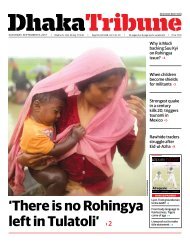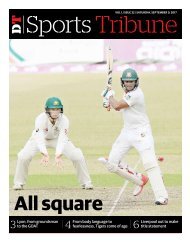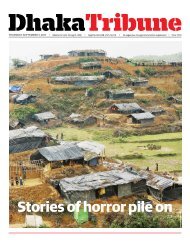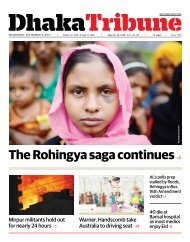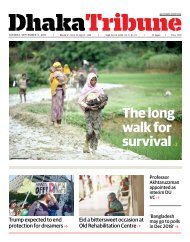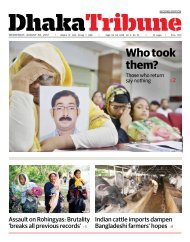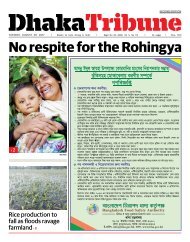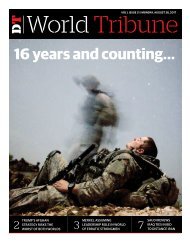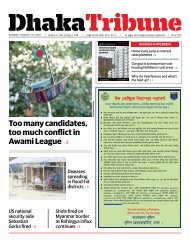e_Paper, Friday, August 25, 2017
You also want an ePaper? Increase the reach of your titles
YUMPU automatically turns print PDFs into web optimized ePapers that Google loves.
6<br />
FRIDAY, AUGUST <strong>25</strong>, <strong>2017</strong><br />
DT<br />
News<br />
Bangladesh importing sacrificial<br />
cattle from Myanmar<br />
• Abdul Aziz, Cox’s Bazar<br />
NATION <br />
The number of cattle being brought<br />
into Bangladesh from Myanmar<br />
ahead of Eid-ul-Azha has more<br />
than doubled in the past two<br />
months compared to the same period<br />
in 2016.<br />
Bangladesh imports most of its<br />
cows, goats and lambs from India<br />
in the run up to the annual religious<br />
festival, when the demand – and<br />
prices – for sacrificial animals soars.<br />
However, the customs officer<br />
for Teknaf land port said the number<br />
of cattle being imported from<br />
Myanmar in July and <strong>August</strong> was<br />
“more than double” that of the<br />
same period in 2016, when 3,435<br />
cattle were brought in for a revenue<br />
of Tk1,963,500.<br />
“There are possibilities for importing<br />
more sacrificial animals<br />
from Myanmar in future,” ASM<br />
Mosharraf Hossain said.<br />
One trader, Amir Mandal,<br />
bought 120 cows and oxen from the<br />
Shahporir Dwip corridor in Teknaf<br />
for sale in Rajshahi.<br />
“Myanmar cows are more popular<br />
than the Indian ones,” he told<br />
the Dhaka Tribune. “They look better<br />
and have more meat.”<br />
Trawlers filled with cattle from Myanmar are making regular arrivals at Shahporir Dwip in Teknaf via the Naf River<br />
Trawlers filled with cattle are<br />
arriving at Shahporir Dwip via the<br />
Naf River. While traders say the<br />
DHAKA TRIBUNE<br />
prices of Myanmar cows are lower<br />
compared to 2016, one jetty lessee<br />
said the import costs were rising.<br />
“The district administration<br />
is charging Tk50 per cow while<br />
Teknaf customs is earning Tk500<br />
revenue from each animal,” said<br />
Rejaul Karim Reju, who is also the<br />
local Union Parishad member.<br />
During the July-<strong>August</strong> period,<br />
local authorities say at least 8,500<br />
cattle have been imported through<br />
the corridor that helped the government<br />
earn Tk4,<strong>25</strong>5,600 in revenue.<br />
Local cattle importer Ham Jalal<br />
said he had bought at least 500<br />
cows in the last two days. “I take<br />
them to Chittagong from here. It<br />
costs about Tk1,800 per animal on<br />
average,” he said.<br />
However, cattle trader Siraj Mia<br />
from Chittagong’s Patia said they<br />
were harassed by police when<br />
transporting the cows.<br />
Teknaf 2 Border Guard Bangladesh<br />
Commander Lt Col SM Ariful<br />
Islam told the Dhaka Tribune that<br />
they were on alert to avert any untoward<br />
incident. •<br />
Russia readies for huge<br />
military exercises as<br />
tensions with west simmer<br />
• Tribune Desk<br />
WORLD <br />
Russia is preparing to mount<br />
what could be one of its biggest<br />
military exercises since<br />
the cold war, a display of power<br />
that will be watched warily<br />
by Nato against a backdrop of<br />
east-west tensions.<br />
Western officials and analysts<br />
estimate up to 100,000<br />
military personnel and logistical<br />
support could participate<br />
in the Zapad (West) 17<br />
exercise, which will take place<br />
next month in Belarus, Kaliningrad<br />
and Russia itself. Moscow<br />
puts the number significantly<br />
lower.<br />
The exercise, to be held<br />
from 14-20 September, comes<br />
against a backdrop of strained<br />
relations between Russia and<br />
the US Congress recently imposed<br />
a fresh round of sanctions<br />
on Moscow in response<br />
to allegations of interference<br />
in the 2016 US election.<br />
The first of the Russian<br />
troops are scheduled to arrive<br />
in Belarus in mid-<strong>August</strong>.<br />
Moscow has portrayed Zapad<br />
17 as a regular exercise,<br />
held every four years, planned<br />
long ago and not a reaction to<br />
the latest round of sanctions.<br />
Nato said it had no plans to<br />
respond to the manoeuvres by<br />
deploying more troops along<br />
the Russian border.<br />
Moscow blames growing<br />
west-east tensions on the expansion<br />
of Nato eastwards and<br />
in recent years the deployment<br />
of more Nato forces in countries<br />
bordering Russia. Nato says the<br />
increased deployments are in<br />
response to the Russian annexation<br />
of Crimea in 2013.<br />
During the cold war, Zapad<br />
was the biggest training<br />
exercise of the Soviet Union<br />
and involved an estimated<br />
100,000 to 150,000 personnel.<br />
After the collapse of the Soviet<br />
Union, it was resurrected in<br />
1999 and has been held every<br />
four years since.<br />
Meanwhile, Russian nuclear-capable<br />
strategic bombers<br />
have flown over the Pacific<br />
Ocean, the Sea of Japan, the<br />
Yellow Sea and the East China<br />
Sea, prompting Japan and<br />
South Korea to scramble jets<br />
to escort them. •




